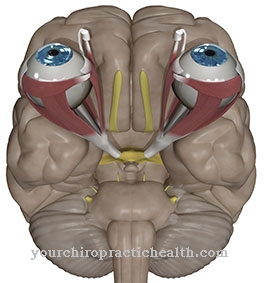Chondroblastomas are benign bone tumors. The benign neoplasm most commonly affects children and adolescents. The treatment is carried out by means of curettage.
What are chondroblastomas?

© freshidea - stock.adobe.com
Bone tissue corresponds particularly to hard connective and supporting tissue and forms the human skeleton. There are between 208 and 212 bones in the human body. All of them can be affected by diseases. Some of these diseases are tissue growth. These neoplasms correspond to either benign or malignant bone tumors.
Chrondroblastoma is a benign bone tumor that is also known in the medical literature as Codman tumor is known. The benign tumor makes up around five percent of all benign bone tumors. Usually symptoms of the tumor show up in the second decade of life.
The tumor usually develops on the epiphysis of long tubular bones. The most common point of origin is the lower end of the thigh bone. Chondromas made of bone or cartilage tissue, which are also benign bone tumors, are closely related to chondroblastoma.
causes
Chrondroblastoma primarily affects adolescents and young adults. In principle, it is a growth disorder that originates from the secondary ossification centers of the epiphyses within long tubular bones. The ossification centers of these bones arise before the ossification of the growth plate and correspond to the tissue zones from which ossification takes place later.
The centers are also known as the bone nuclei. As a rule, bones have several ossification cores that start the ossification process at different times. As for all neoplasms, the cause of a chondroblastoma is essentially a malfunction or dysregulation of cell growth processes.
Genetic predispositions play a decisive role in this. However, an internal genetic predisposition to develop a chondroblastoma does not necessarily have to result in actual training. External factors activate, so to speak, the actual growth processes.
Symptoms, ailments & signs
Chondroblastomas are extremely slow-growing bone tumors that originate from the ossification centers of the long tubular bones. They preferentially arise on the thigh bones. Most adolescents develop chondroblastomas in the growth process. The neoplasms usually do not cause any symptoms until the second decade of life.
The first symptoms often appear between the ages of 20 and 30 years. These complaints can correspond to pain, which in many cases can be traced back to effusions in adjacent joints. The larger the tumor, the greater the impairment of the joint and with it the pain symptoms.
At a certain point in time, the pain can be so severe that the patient's motor skills are impaired. The pain symptoms increase depending on the load. For this reason, some affected people adopt a relieving posture while walking or standing.
Growth-inhibiting processes can also be caused by the tumor. Chondroblastoma is essentially a benign tumor, but metastases can occur despite this classification. The metastases of this type of tumor mostly affect the lungs.
diagnosis
After taking the anamnesis, the doctor will order an imaging of the skeleton if there are any symptoms. All neoplasms can be seen on the imaging, but often not clearly classified as good or malignant. The tissue examination is generally indicated to classify new bone formation.
This classification usually requires a biopsy of the affected area. In the investigation, the chondroblastoma shows up as a sharply demarcated tumor of chondroblast-like cells and giant cells. For patients with chondroblastomas, the prognosis depends primarily on whether there are metastases in the lungs.
When should you go to the doctor?
If there is pain in the area of the joints that cannot be attributed to any specific cause, it is necessary to seek medical advice. Other warning signs that require medical clarification are motor disorders and an increasing reluctance to posture. Corresponding symptoms increase in the course of the disease and indicate a serious illness that must be diagnosed and treated in any case. The doctor can use a medical history and various diagnostic procedures to determine whether it is a chondroblastoma. Appropriate therapy can then be started.
If the disease is left untreated, the metastases increase in size and number and sometimes spread to the lungs. Unusual symptoms such as pain, restricted mobility or numbness in the limbs should therefore be investigated immediately. Risk groups such as patients with genetic predispositions or people who have been exposed to increased radiation exposure should consult a doctor immediately. Since chondroblastomas usually form between the ages of twenties and thirties, additional preventive examinations are indicated during this period.
Doctors & therapists in your area
Treatment & Therapy
Symptomatic therapy with painkillers is not indicated for chondroblastomas. The therapy of choice for bone tumors corresponds to curettage of the tumor tissue. This surgically mechanical scraping or scraping out of the bone is carried out by the surgeon with a sharp-edged instrument that is shaped for the anatomical area of application within the bones.
With this curette, the surgeon removes the tumor tissue as completely as possible and then fills the tissue defect with cancellous bone. In some cases, he also uses a temporary cement seal that stabilizes the defect in the bone tissue. The seal allows possible recurrences to be identified and eliminated at an early stage.
Since the chondroblastoma mostly affects patients who are growing older and is particularly often located in the immediate vicinity of a joint, the surgeon often has to remove any cement that may be used after two years at the latest. This requires a second operation in which the seal is removed and the bone hole is filled with cancellous bone. Since recurrences occur in ten to thirty percent of all cases, follow-up examinations should be observed after the operation.
As long as the soft tissues are not affected, an en bloc resection is used to treat possible recurrences. An en bloc resection is a procedure that removes not only the actual findings but also the neighboring tissue in one piece with the tumor in the same surgical procedure. If, on the other hand, the recurrences are accompanied by soft tissue involvement, the largest possible tumor resection is used.
For many patients with chondroblastoma, drug therapy is an option for metastases in the lungs. Depending on the metastases in each individual case, the attending physician decides between drug therapy and invasive removal of the metastatic foci.
Outlook & forecast
In the case of chondroblastoma, the prognosis is based on the stage of the disease and the location of any metastases. Individual tumors can usually be permanently removed by surgery. Sometimes radiation or chemotherapy is also possible. In the case of a larger infestation, the prognosis depends on whether organs are affected. Complete removal of a chondroblastoma often involves the removal of pieces of bone or entire limbs. In addition, growth disorders or organ damage that have already occurred can usually no longer be corrected.
The prospect of a symptom-free life is there, but there may be restrictions in the quality of life. Especially in children and adolescents before puberty and in older patients, the disease itself is as associated with risks as the treatment.
If tumors have already penetrated the lungs, the prognosis is rather poor. The patient must immediately undergo radiation or chemotherapy, which is an enormous burden on the body. After treatment, recurrences can occur or the original chondroblastoma causes further symptoms. A close inspection by a doctor is necessary in every case.
prevention
For chondroblastomas and other neoplasms, genetic predisposition plays a role that should not be underestimated. Although external factors are also involved in the formation of tumors, neither the internal nor the external factors can be completely eliminated. If there is a corresponding predisposition, check-ups of the skeleton should be performed. However, these controls expose the skeleton to radiation, which as an external factor can promote bone tumors.
Aftercare
Physical treatment is part of the follow-up care after the surgical removal of a chondroblastoma. This is used to strengthen the muscles and restore the original function of the affected joint. There is often a tendency for local recurrence. For this reason, regular check-ups must be carried out.
These show at an early stage whether a new infestation appears. The sooner the doctor recognizes this, the better he can fight the tumor. An en bloc resection is usually used as part of the follow-up treatment. If cement was used in the immediate vicinity of the joint during the operation of people who are still growing, it must be removed after two years at the latest in order to avoid malformations.
Then the doctor fills the defect with cancellous bone. Depending on the severity of the disease, patients can live symptom-free after the operation. But there are also risks to be expected, especially in the growth phase. There is also a risk of complications for older people. Overloading the joint should be avoided during the subsequent therapy. Here it is immanent to adhere to the exact recommendations of the doctor and physiotherapist. Psychotherapy can also be useful for the holistic well-being of the patient.
You can do that yourself
In the case of chondroblastomas, the most important self-help measure is an immediate clarification of the warning signs.A doctor visit is indicated as soon as bone pain, restricted mobility and similar symptoms are noticed.
After the condition is diagnosed, the patient must undergo extensive treatment. Since chemotherapy and radiation therapy place a considerable strain on the body, rest is indicated. In the first few weeks and months in particular, strenuous physical activity should be avoided. Various remedies from homeopathy can be used under certain circumstances.
However, this should first be discussed with the doctor. In addition, it can be useful to change your diet. Depending on the requirements of the doctor, irritating foods, among other things, must be removed from the menu. It is also advisable to avoid certain foods that could promote the growth of tumors. The individual diet is best put together in consultation with a specialist or a nutritionist.
After treatment has ended, the person concerned should consult a doctor regularly. Chrondroblastomas have a relatively high risk of recurrence. These must be recognized and treated to avoid serious complications.



.jpg)

.jpg)






.jpg)



.jpg)










.jpg)
